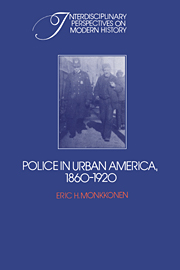4 - A narrowing of function
Published online by Cambridge University Press: 23 October 2009
Summary
There is in every large city, a dangerous class of idle, vicious persons, eager to band themselves together, for purposes subversive to public peace, and good government …
Report of the General Superintendent of Police, Chicago (1876) [beginning of Haymarket Affair report]Police and crime
In Chapter 2, we examined the extreme variations in the arrest rate trends relative to larger social and economic events. In this chapter, the rates will be examined more narrowly and precisely from the perspective of the direct producers of the arrest rates, the police. Following methodological techniques implied by the modified labeling perspective described in the Introduction, the explicit causal world here will be restricted to measurable variations in the police and to immediate forces predicted to affect police behavior. The measure of police behavior is, of course, variation in arrests. Variation in police behavior, arrests, which cannot be explained with the severely simple models specified here, will be subjected, in the next section, to a more speculative analysis of external forces that affected long trends. In a sense, up to this point we have been looking at arrest rates in their larger social context while ignoring the concrete conditions of their production. What we want to see now is how much can be explained by policing alone: What remains, we can more confidently attribute to other social causes.
- Type
- Chapter
- Information
- Police in Urban America, 1860–1920 , pp. 129 - 147Publisher: Cambridge University PressPrint publication year: 1981



